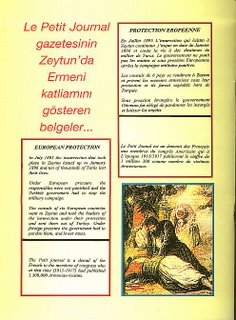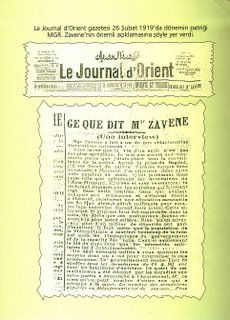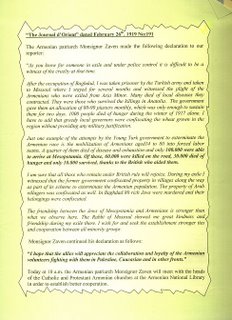
(Picture: Armenians massacring Muslims in Zeytun) Translated explanation:
EUROPEAN PROTECTION
In July 1895 the insurrection that took place in Zeytun lasted up to January 1896 and ten thousands of Turks lost their lives.
Under European pressure the responsible were not punished and the Turkish government had to stop the military campaign
The consuls of six European countries went to Zeytun and took the leaders of the insurrection under their protection and sent them out of Turkey. Under foreign pressure the government had to pardon them, and lower taxes..
The Petit Journal is a denial of the French to the members of congress who at that time (1915-1917) had published 1.300.000 Armenian victims.
Extracts from French military reports regarding atrocities committed by the Armenian Legion against Turks in Cilicia' from General du Hays, Les Armees Francaises au Levant, 1919-1939, Tome I: L7Occupation Francaise en Syrie et en Cilicie sous le Commandment Britanique, Nov. 1918 - Dec. 1919 (Ministere de la Defense, Etat Major de l'Armee de Terre, Service Historique Chateau de Vincennes, 1938) pp. 123-128.
" (General Hamelin) clearly saw that to send the Armenian legionnaires to Cilicia and Alexandretta was to supply powder and detonator to the situation. Incidents and disorders followed with little delay. On Jan.3, 1919 in the small village of Euzerli, near Deurtyol a quarrel broke out between the Armenian Legionnaires and the Turkish civilians. One Turk was killed and there were eight wounded on both sides. The legionnaires then assaulted the village and seven civilians were killed… The gravest incident took place at Alexandretta during the night of the 16-17 February . Following a quarrel between (Senegalese) riflemen and Armenian legionnaires, gunfire was exchanged and a legionnaire was wounded. Then the legionnaires of the battalion which had just been formed and was poorly disciplined and weakly organized, spread out in the town, assaulted the Turkish inhabitants and pillaged and burned two houses… The 4th battalion of the Armenian Legion was then disarmed…some were distributed among the other forces, but some 400 were returned to Port Said… Numerous incidents took place this time, so at the start of March 1919 the British commander requested that the entire Armenian Legion be removed from Cilicia and sent to Morocco. However the regulations of the Legion did not permit it to be sent outside Cilicia. The only solution in this situation, therefore, according to General Hamelin, to gradually dissolve it through selection and losses in battle Finally to make some use of the Armenian legionnaires, the 21st corps ordered that they be taken out of the villages and stationed instead along the railroad to guard it. But after new incidents took place, orders were issued to remove them from the railroad as well. The spirit and the morale of the Armenians became worse and worse, there were large numbers of desertions, and General Difieux, who had commanded the Legion for some time, concluded that the only solution was to dissolve the Legion because it had caused so many difficulties. The order of dissolution was given in August to take effect in September 1920 "

Photo # 1: Title "ARMENIAN VOLUNTEERS IN NAZI WEHRMARCHT SWEAR
LOYALTY TO FUHRER
(Showing German soldiers with three new soldiers in front of German flag, with right hands up in the Nazi salute)
Photo taken 5th August 1944 by German War Correspondent, Strohmeyer.

Title: ARMENIAN VOLUNTEERS FROM TURKEY IN NAZI SERVICE DURING WORLD WAR II: BERLIN 1943
Above: Armenians on Paul Leverkuen's staff visit Nazi Propaganda Minister Joseph Paul Goebbels before returning to Middle East to spread Nazi propaganda from base in Adana. (Photo shows four soldiers facing Goebbels and Gen. Leverkuen)
Below: Title: Armenian volunteers in Wehrmacht training before dispatch to join Nazi invasion of Soviet Union.
(Photo shows some soldiers in a barbed wire battlefield in running status)
(Below excerpts added to bring additional l information about the whereabouts of photos)
"The Great War and the Tragedy of Anatolia" Salahi Sonyel ISBN 075-16-1227-6 P.182-3
Cooperation between the Armenians and the Nazis
During World War II, while the Turkish government was giving asylum to many Jews from Hitler's tyranny, anti Semitism engulfed the Armenian circles in the Nazi-occupied territories. A publication of the Armenian Information Service in New York, entitled "Dashnak collaboration with the Nazi regime" purports the show that Armenian sympathies with racism had reached dangerous proportions. The following quotation from the Armenian daily newspaper Hairenik of 19, 20 and 21 August 1936, exposes something much more than prejudice and bigotry.
Jews being the most fanatical nationalists and race-worshippers… are compelled to create an atmosphere… of internationalism and world citizenship in order to preserve their race… As the British use battleships to occupy lands… Jews use internationalism or communism as a weapon… Sometimes it is difficult to eradicate these poisonous elements when they have struck deep root like a chronic disease. And when it becomes necessary for a people to eradicate them… these attempts are regarded revolutionary. During a surgical operation, the flow of blood is a natural thing… Under such conditions, dictatorships seem to have a role of saviours…"
In May 1935 the Armenians of Bucharest attacked the Jews of that city, while the Greeks of Salonika attacked the Jews in the August of the same year. During World War II, Armenian volunteers, under the wings of Hitler's Germany, were used in rounding up Jews and other 'undesirables' destined for the Nazi concentration camps. The Armenians also published a German-language magazine, with fascist and anti-Semitic tendencies supporting Nazi doctrines directed to the extermination of 'inferior' races.
This is confirmed by one of the champions of Armenians, Christopher J. Walker, who admits that Armenians collaborated with Nazis. According to him, members of the Dashnak Party, when living the occupied areas, including a number of prominent persons, entertained pro-Axis sympathies. A report in an American magazine went so far as to claim that the Nazis had picked Dashnaktsutiun to do the fifth-column work, promising the party autonomous state for its cooperation. Walker goes on to state that relations between the Nazis and the Dashnakists living in the occupied areas were close and active. On 30 Dec. 1941 an Armenian battalion was created by decision of the Army Command (Wehrmacht), known as the 'Armenian 812th Battalion'. It was commanded by Dro, a former Armenian guerilla leader, and was made up of a small number of committed recruits, and a larger number of Armenians from the prisoners of war, taken by the Nazis in their sweep eastwards. Early on, the total number of recruits was 8,000; this number later grew up to 20,000. The 812th Battalion was operational in the Crimea and North Caucasus.
A year later, on 15 Dec. 1942, an 'Armenian National Council' was granted official recognition by Alfred Rosenberg, the German Minister of the occupied areas. The Council's president was Prof. Ardashes Abeghian, its vice-president Abraham Giulkhandanian, and it numbered among its members Mzdeh and Vahan Papazian. From that date until the end of 1944 it published a weekly journal, Armenien, edited by Viken Shant (son of Levon), who also broadcast on Radio Berlin. The whole idea was to prove to the Germans that the Armenians were 'Aryans', in order to save their skins, claims Walker. With the aid of Dr. Paul Rohrbach they seem to have achieved this as the Nazis did not persecute the Armenians in the occupied lands.

(English translation of the French newspaper "Journal d'Orient" Feb. 26, 1919 No. 191)
The Armenian patriarch Monsignor Zaven, made the following declaration to our reporter:
" As you know for someone in exile and under police control it is difficult to be a witness of the cruelty at that time.
After the occupation of Baghdad, I was taken prisoner by the Turkish army and taken to Mossoul where I stayed for several months and witnessed the plight of the Armenians who were exiled from Asia Minor. Many died of local diseases they contracted. They were those who survived the killings in Anatolia. The government gave them an allocation of 80-90 piasters monthly, which was only enough to sustain them for two days. 1000 people died of hunger during the winter of 1917 alone. I had to add that greedy local governors were confiscating the wheat grown in the region without providing any military justification.
Just one example of the attempts by the Young Turk government to exterminate the Armenian race is the mobilization of the Armenians aged 14 to 80 into forced labor teams. A quarter of them died of disease and exhaustion and only 100.000 were able to arrive in Mesopotamia. Of these, 60.000 were killed on the road, 30.000 died of hunger and only 10.000 survived, thanks to the British who aided them.
I am sure that all those who remain under British rule will rejoice. During my exile I witnessed that the former government confiscated property in villages along the way as part of its scheme to exterminate the Armenian population. The property of Arab villagers was confiscated as well. In Baghdad 80 rich Jews were murdered and their belongings were confiscated.
The friendship between the Jews of Mesopotamia and Armenians is stronger than what we observe here. The Rabbi of Mossoul showed me great kindness and friendship during my exile there. I wish for and seek the establishment stronger ties and cooperation between all minority groups.
Monsignor Zaven continued his declaration as follows:
"I hope that the allies will appreciate the collaboration and loyalty of the Armenian volunteers fighting with them in Palestine, Caucasian and other fronts."
Today at 10 a.m. the Armenian patriarch Monsignor Zaven will meet with the heads of the Catholic and Protestant Armenian Churches at the Armenian National Library in order to establish better cooperation.

NOTES by S.S.AYA :
* The editor of this newspaper is a Jew Albert Garasso in Galata, Istanbul. At the time this interview was made, Istanbul was under Allied occupation. Apparently Patriarch Zaven, had just returned from Baghdad and both sides were trying to improve the relations between Jews and Armenians of the occupied and destructed Empire.
* Some given details do not correspond with other sources and impression of hearsays plus boastings is visible.
Kindly Provided by Sukru Server Aya








0 comments:
Post a Comment
Please Update/Correct Any Of The
3700+ Posts by Leaving Your Comments Here
- - - YOUR OPINION Matters To Us - - -
We Promise To Publish Them Even If We May Not Share The Same View
Mind You,
You Would Not Be Allowed Such Freedom In Most Of The Other Sites At All.
You understand that the site content express the author's views, not necessarily those of the site. You also agree that you will not post any material which is false, hateful, threatening, invasive of a person’s privacy, or in violation of any law.
- Please READ the POST FIRST then enter YOUR comment in English by referring to the SPECIFIC POINTS in the post and DO preview your comment for proper grammar /spelling.
-Need to correct the one you have already sent?
please enter a -New Comment- We'll keep the latest version
- Spammers: Your comment will appear here only in your dreams
More . . :
http://armenians-1915.blogspot.com/2007/05/Submit-Your-Article.html
All the best